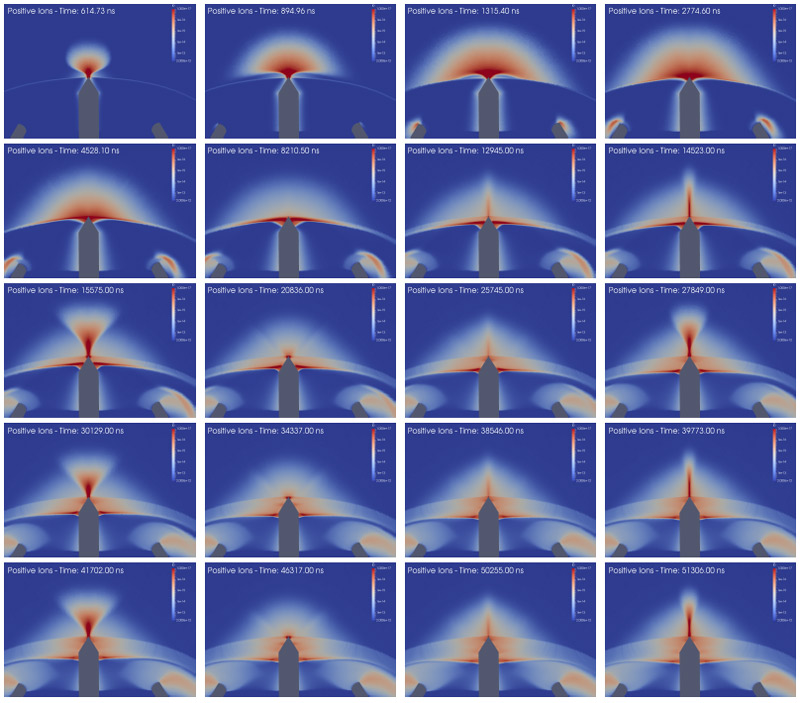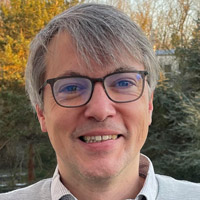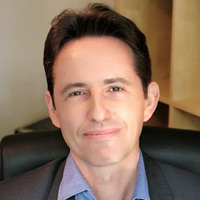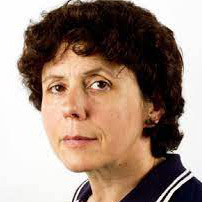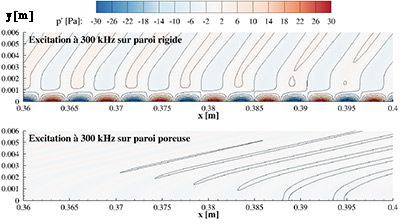- ONERA
- Research - Aeronautics Space Defense
- Scientific Domains
- The Advanced Numerical Simulation Domain
The Advanced Numerical Simulation Domain
The SNA Scientific Domain

Denis Gueyffier
Scientific director
of the Advanced Numerical Simulation domain (SNA)
Highlights
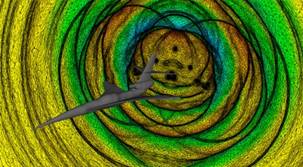 ONERA and INRIA have join forces to form the GammaO team, based on INRIA's Gamma team (meshing methods for numerical simulation). This alliance will accelerate the adoption of adaptive meshing methods for ASD applications such as combustion, magneto-hydro-dynamics, plasma and hypersonic flows.
ONERA and INRIA have join forces to form the GammaO team, based on INRIA's Gamma team (meshing methods for numerical simulation). This alliance will accelerate the adoption of adaptive meshing methods for ASD applications such as combustion, magneto-hydro-dynamics, plasma and hypersonic flows.
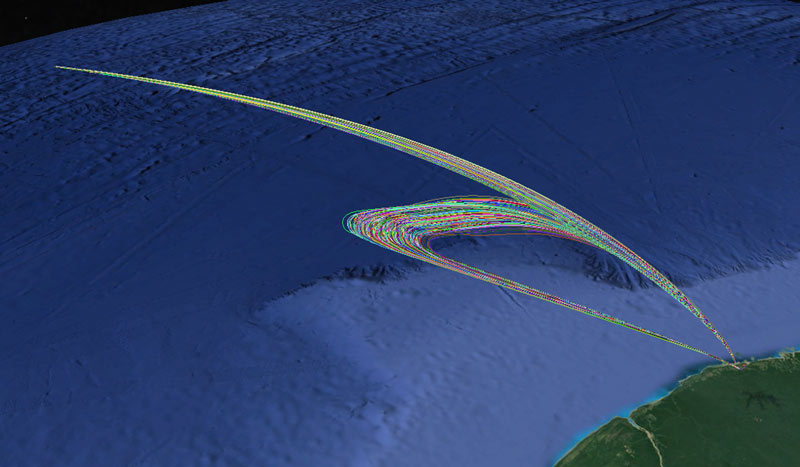 ONERA co-founded the LARTISSTE scientific interest group (GIS) for the quantification of uncertainties, with Université Paris-Saclay and a very wide range of participants, from academic research to industry, including major organizations such as Airbus, Safran, EDF, CEA, IFPEN, Cerfacs, ENS Paris-Saclay, CentraleSupélec... This GIS, which brings together major players in the energy and aeronautics sectors, will explore important issues of numerical models for the reasoned use of numerical models for prediction and decision-making purposes.
ONERA co-founded the LARTISSTE scientific interest group (GIS) for the quantification of uncertainties, with Université Paris-Saclay and a very wide range of participants, from academic research to industry, including major organizations such as Airbus, Safran, EDF, CEA, IFPEN, Cerfacs, ENS Paris-Saclay, CentraleSupélec... This GIS, which brings together major players in the energy and aeronautics sectors, will explore important issues of numerical models for the reasoned use of numerical models for prediction and decision-making purposes.
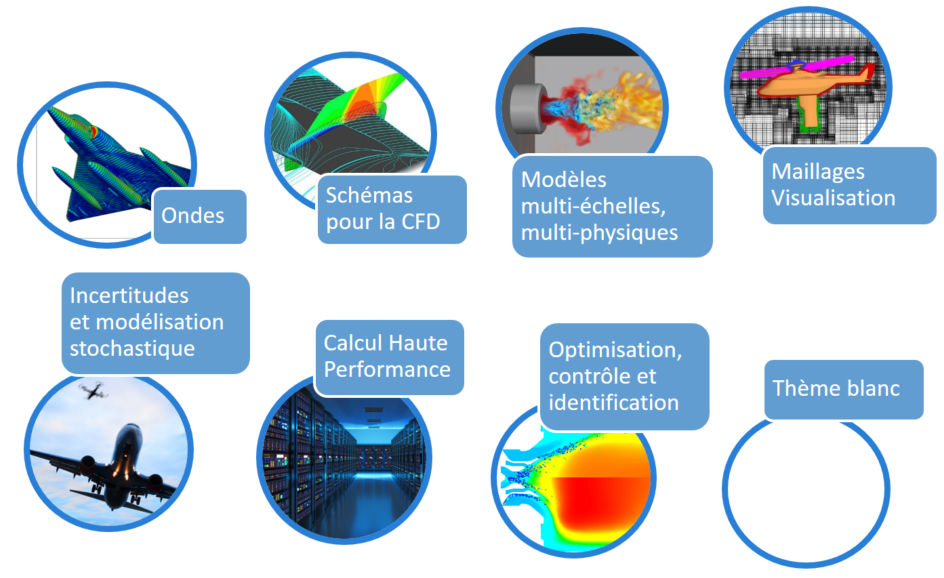 LMA2S Maths Apps Lab - Laboratory of Applied Mathematics for Aeronautics and Space is a virtual inter-departmental laboratory (created in 2019) that federates ONERA's scientific community of mathematicians and numerical engineers, giving it greater visibility. The aim is to optimize the resources allocated to this discipline by encouraging the pooling of work.. [w3.onera.fr/lma2s]
LMA2S Maths Apps Lab - Laboratory of Applied Mathematics for Aeronautics and Space is a virtual inter-departmental laboratory (created in 2019) that federates ONERA's scientific community of mathematicians and numerical engineers, giving it greater visibility. The aim is to optimize the resources allocated to this discipline by encouraging the pooling of work.. [w3.onera.fr/lma2s]
Next-generation software SONICS and A-set are the digital simulation codes of the future for ONERA and its partners, respectively for aerodynamics and mechanics of materials and structures, in partnership with the Safran group.
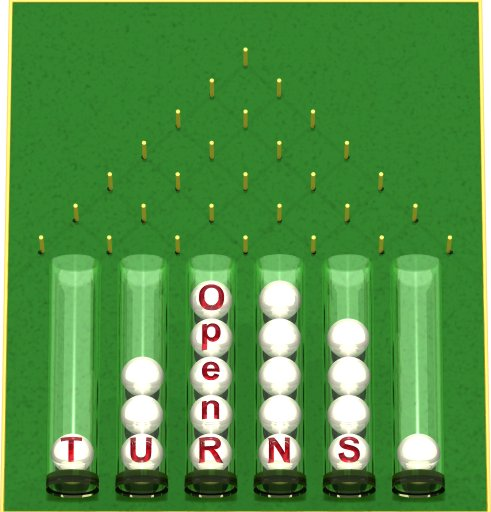 ONERA is a member of the consortium OpenTURNS is a software library written in Python and C++ dedicated to the treatment of uncertainties in numerical simulation. The consortium includes Airbus, EDF R&D, IMACS (Polytechnique), Phimeca and ONERA.
ONERA is a member of the consortium OpenTURNS is a software library written in Python and C++ dedicated to the treatment of uncertainties in numerical simulation. The consortium includes Airbus, EDF R&D, IMACS (Polytechnique), Phimeca and ONERA.
SNA in brief
SNA integrates the entire research and development process associated with ONERA's scientific and technical production in the form of software, and thus covers, for all physics disciplines, research on modeling, studies on algorithms and applied mathematics, high-performance computing issues, coupling between different physics, model reduction techniques and propagation and quantification of uncertainties.
The aims of numerical simulation are to provide an in-depth understanding of physics, to meet the needs of government agencies (safety, environment, certification, etc.) and to enhance the competitiveness of industry. These activities are underpinned by high-level fundamental research and fruitful collaborations, leading to structuring projects that are often large-scale and long-term.
ONERA's software products take full advantage of ONERA's unique positioning. In addition to the triptych of experimentation-modeling-simulation and the availability of multi-disciplinary skills in physical modeling and digital sciences, the close relationships forged with industrial partners enable detailed and evolving knowledge of needs, rapid transfer of research to industry and validation through use on realistic configurations. ONERA's development of its own software meets its need for research autonomy and capitalization on its scientific and technical heritage.
The SNA domain concerns the development of methods and tools for numerical simulation. SNA is a cross-disciplinary field in close interaction with the four other scientific domains and ONERA's seven research departments.
Scientific Officers
SNA themes
The SNA domain brings together three main scientific themes spread across four ONERA departments : Materials and Structures ; Multiphysics for Energy ; Aerodynamics, Aeroelasticity, Acoustics ; Information Processing and Systems:
- Numerical Methods and High-Performance Computing DMAS DMPE DAAA
- Applied mathematics and interactions, scientific computing DTIS
Numerous other scientific fields are related to the SNA domain. Examples include
- Acoustics; multi-fidelity optimization; multiphase flows; reactive flows MFE
- Aeroelasticity; structural mechanics; structural design and optimization MAS
- Simulation of the electromagnetic scene; environment and signatures for optronic sensors; lightning, plasmas and electric thrusters PHY
- Systems design and optimization TIS
Numerical methods & High-Performance Computing
DMAS Johann Rannou
- Development of finite element methods : theory, technology, software engineering
- Code coupling for multiphysics and multiscale modeling
- Model reduction
- New methods for high-performance computing (HPC) and exploitation of massive data
- Structural optimization algorithms
- Test-simulation dialogue algorithms
- Uncertainties and stochastic modeling
Examples
Phase field and cohesive zone simulation of accreted ice shedding
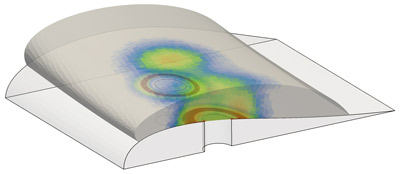 This type of calculation is carried out in order to develop a technological test dedicated to be implemented in ONERA's icing wind tunnel. Once a block of ice has formed on a profile, pressurized air is injected to induce detachment, and the characteristics of the detached ice are studied in relation to the aero-icing conditions and the characteristics of the substrate. Calculations are performed using the Z-set code, exploiting its parallel resolution capabilities. This work is carried out in collaboration with the Multiphysics department for energy as part of the ONERA TRICEPS project.
This type of calculation is carried out in order to develop a technological test dedicated to be implemented in ONERA's icing wind tunnel. Once a block of ice has formed on a profile, pressurized air is injected to induce detachment, and the characteristics of the detached ice are studied in relation to the aero-icing conditions and the characteristics of the substrate. Calculations are performed using the Z-set code, exploiting its parallel resolution capabilities. This work is carried out in collaboration with the Multiphysics department for energy as part of the ONERA TRICEPS project.

DMPE Guillaume Puigt, Eric Quémerais, Ghislain Blanchard
- Space-time discretization: focus on finite volume and spectral differences
- Meshes: mesh operations, mesh adaptation, high-order curved mesh, etc.
- Multi-physics coupling: multi-solver coupling, multi-fluid approaches, fluid and solid particles, atomization...
- Adjoint methods: sensitivities, mesh adaptation...
- Eigenvalue problems
- Large linear systems: implicit methods for multi-physics...
- HPC: mesh management, solver architecture for HPC
Examples
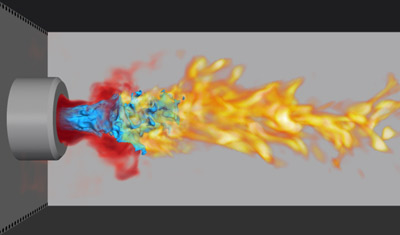
Finite Volume Axis - Cedre solver Objective: spatial scheme of order greater than 2 on unstructured mesh.
Example of application to primary atomization in cryogenic combustion (VF with 2nd-order multipent MUSCL scheme).
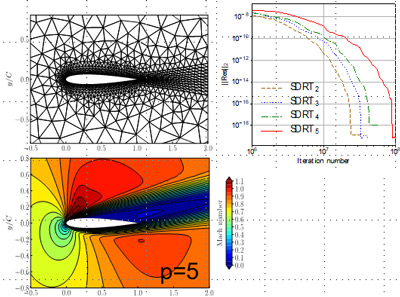
Spectral Difference axis - JAGUAR solver Objective: scheme development on triangle/tetrahedron.
Family of schemes of order 3 to 6 (p=2 to 5) on triangles, convergence of calculations on laminar transonic NACA12 at Minfini=0.8, ;Alpha=10°, Re=500, despite non-alignment of mesh/solution.
JEROBOAM is a collaborative project focusing on discontinuous spectral methods for which the solutions in each cell are defined as polynomials of given degree p, and for which no continuity of fields at cell interfaces is assumed. These approaches provide a class of numerical schemes whose order is controllable, and by their "mathematical nature" enable good scalability on massively parallel machines (here, measured scalability of 96% on more than 121,000 cores for the JAGUAR solver). We are interested in these approaches in a perfect gas and reactive multi-species gas context. At the heart of the project: numerical time integration schemes, spatial numerical schemes including shock capture and entropy schemes, coupling for multiphysics, boundary conditions for large-scale turbulence simulations... Validation of these approaches involves stationary (minority) and especially unsteady flows, in order to demonstrate the LES-like capabilities of the approaches. The project ends fall 2023 and will continue with HOGSMEADE, with a specific focus on multi-species flows, shocks, and Euler/Euler approach for liquid/gaz interaction.
DAAA Cédric Content, Ivan Mary, Jean-Baptiste Chapelier
- Space and time discretization
- Schemes for hypersonic flows
- Inversion of ill-conditioned linear systems
- Coupling methods for multiphysics
- A posteriori error estimation
- Mesh (h), scheme (p) and model (m) adaptations
- High-order CAD representation
- Methods for long-range noise propagation
Examples
REALITY - High-order numerical schemes for compressible fluid mechanics. To reduce aircraft design costs, numerical simulation has become an indispensable tool. We are concerned with turbulent flow phenomena characterized by a wide range of time and space scales. The use of high-accuracy methods for their simulation is becoming a necessity as the levels of accuracy requiored in the aeronautical industry tend to become ever higher. In this context, the REALITY project aimed to enhance the robustness and efficiency of high-order simulations of compressible fluid mechanics equations (encompassing turbulence, multi-species and two-phase models) using discontinuous Galerkin methods, where the solution is sought as piecewise polynomials in each element of unstructured polyhedral meshes.

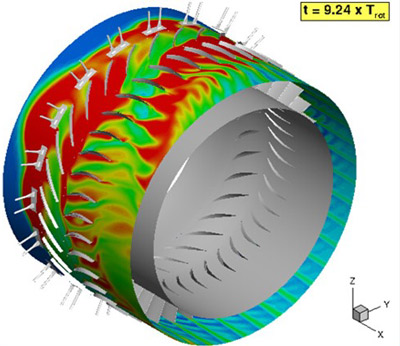 The European CleanSky2 ACONIT project (2020-2023, with ENSAM, Bundeswehr University Munich and CETC), aims to bring fluidic control technology closer to industrial use in aircraft engine compressors, in order to reduce pumping margin.
The European CleanSky2 ACONIT project (2020-2023, with ENSAM, Bundeswehr University Munich and CETC), aims to bring fluidic control technology closer to industrial use in aircraft engine compressors, in order to reduce pumping margin.
ONERA's first activity in this project was to evaluate the ability of elsA software to predict the limit of operability (rotating stall) of the CME2 compressor (Laboratoire de Mécanique de Fluides de Lille) using unsteady simulations over its entire circumference. Experimentally, only one stalled cell was observed. The simulations have enabled us to gain a better understanding of the mechanisms involved in the stall of the CME2 compressor rotor in the absence of fluidic control. As a result, elsA is able to reproduce the single-cell rotating stall observed during testing.
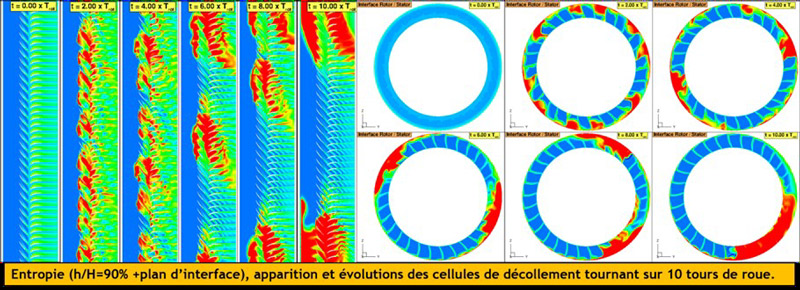
The next step involved numerical simulations of rotating stall control on the same CME2 compressor fitted with fluidic injectors. The simulations model the entire circumference of the machine, including the complete injector geometry (20 pairs of injectors distributed over the entire circumference). Simulations show the beneficial effect of fluidic control. The actuators modify the flow within the compressor, delaying entry into rotating stall by shifting it towards lower engine flows. Ultimately, this will enable the engine to operate at a higher efficiency level, and therefore with lower fuel consumption, over a wider operating range.
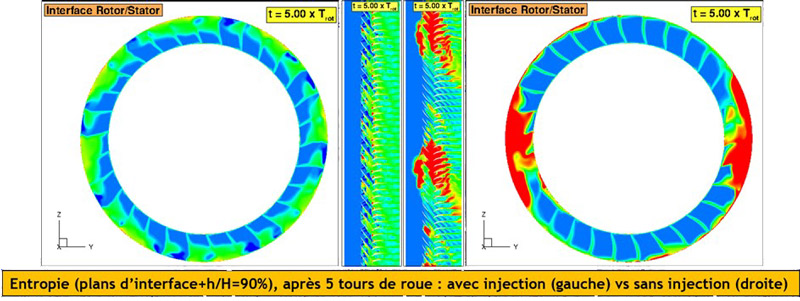
- Deformation and mesh adaptation (fluid and structure)
- Lattice-Boltzmann method (LBM)
- Chimera technique, IBM
- Octree
- Numerical methods for parallel and exascale computing
- Software architecture
- Pre- and post-processing of calculations
- Validation on complex configurations and international benchmarks
- MDA (high-fidelity model, code coupling)
Exemples
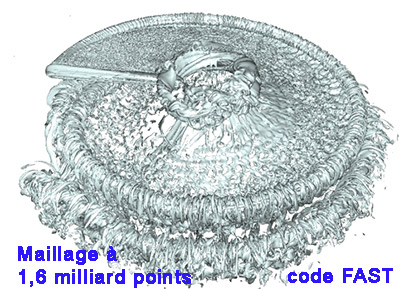 AHFIR cooperation One of the objectives of the cooperation between ONERA and the US Army is to evaluate and compare the immersed boundary methods developed by ONERA in the ONERA FAST/IBM environment and by the US Army in HELIOS/ROAM on a rotor-fuselage interaction case and on the evaluation of the drag of a helicopter rotor head in a wind tunnel. The aim is twofold: to be able to carry out CFD simulations in a rapid restitution time around complex geometries, while at the same time capturing the physics in a sufficiently precise way, for which so-called "low-fidelity" methods alone are not appropriate. ONERA has therefore adopted an original approach to calculating this type of configuration. Rotating blades are discretized by moving curvilinear meshes, for which a URANS model is used. The helicopter fuselage is taken into account by Cartesian meshes using a immersed boundary method. As a result, calculations can be carried out in just a few tens of minutes, even for very complex geometries, as the process is automated.
AHFIR cooperation One of the objectives of the cooperation between ONERA and the US Army is to evaluate and compare the immersed boundary methods developed by ONERA in the ONERA FAST/IBM environment and by the US Army in HELIOS/ROAM on a rotor-fuselage interaction case and on the evaluation of the drag of a helicopter rotor head in a wind tunnel. The aim is twofold: to be able to carry out CFD simulations in a rapid restitution time around complex geometries, while at the same time capturing the physics in a sufficiently precise way, for which so-called "low-fidelity" methods alone are not appropriate. ONERA has therefore adopted an original approach to calculating this type of configuration. Rotating blades are discretized by moving curvilinear meshes, for which a URANS model is used. The helicopter fuselage is taken into account by Cartesian meshes using a immersed boundary method. As a result, calculations can be carried out in just a few tens of minutes, even for very complex geometries, as the process is automated.
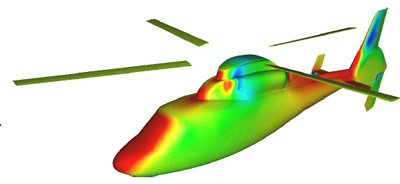 The coupling between the rotating curvilinear grids and the Cartesian mesh is achieved by an optimized Chimère approach, which limits the transfer time between grids to 20% of the overall time. The calculations are implemented by coupling Python/CGNS HPC modules developed by ONERA/DAAA (Cassiopee, FastS, Quantum...). The first figure illustrates an academic calculation of the wake generated by an isolated blade, while the next two figures represent a more industrial case of a 4-blade rotor in forward flight modeled by a URANS model which takes into account the interaction with the fuselage thanks to a immersed boundary method.
The coupling between the rotating curvilinear grids and the Cartesian mesh is achieved by an optimized Chimère approach, which limits the transfer time between grids to 20% of the overall time. The calculations are implemented by coupling Python/CGNS HPC modules developed by ONERA/DAAA (Cassiopee, FastS, Quantum...). The first figure illustrates an academic calculation of the wake generated by an isolated blade, while the next two figures represent a more industrial case of a 4-blade rotor in forward flight modeled by a URANS model which takes into account the interaction with the fuselage thanks to a immersed boundary method.
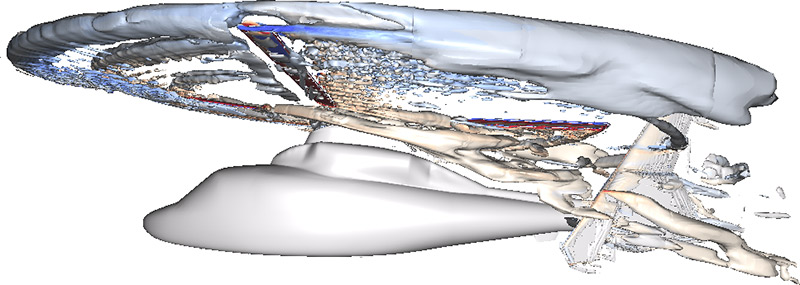
Applied mathematics and interactions, scientific computing
DTIS Guillaume Dufour, Sébastien Pernet
- Numerical analysis of PDEs, Inverse Problems
- Particle models
- High-performance computing HPC
- Mesh adaptation
- Coupling of numerical models
- Uncertainty propagation, treatment of rare events
- Optimization, sensitivity analysis
- Substitution models
- Multi-physics and multi-scale simulations
Examples
Simulation of a tip-plane plasma discharge in a Mach 3 flow. The test case studied concerns the interaction of a plasma generated by a negativepoint-to-plane discharge with a shock wave from a supersonic flow.
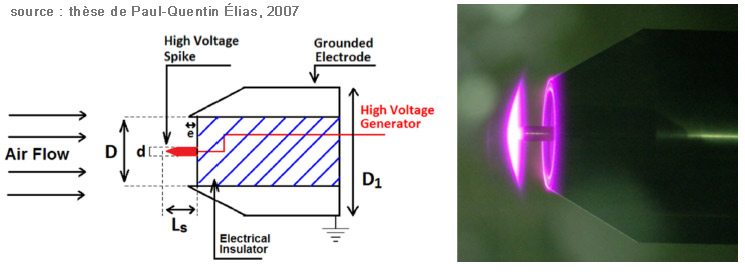
The calculation was carried out using the COPAIER code, which is able to perform simulations of plasmas outside of the thermodynamic equilibrium assumption, for 2D or 2D-axisymmetric geometries. The solver is based on the resolution of conservation equations (of the convection-diffusion-reaction type) for the dynamics of charged species densities, coupled with the computation of the electric field induced by the potential applied to the stressed electrode (here -7.5 kV) and by the volume charge distribution.
This is a multi-scale simulation in time and space. Indeed, to correctly represent field effects, mesh sizes must be of the order of Debye's length - micrometric in our case - while the device size is centimetric. On these mesh sizes, the CFL condition corresponding to electron transport imposes time steps of less than a picosecond, while the characteristic time of flow along the device is more in the order of a hundred microseconds (8 orders of magnitude).
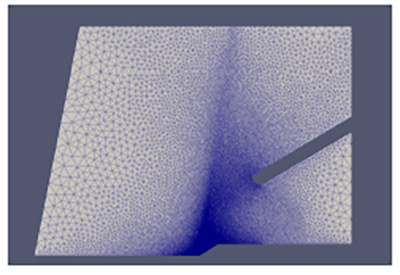 The calculations were carried out on an unstructured mesh, on ONERA's SPIRO parallel computer, using 32 cores distributed over two computing nodes. By taking charge separation into account and resolving the complete electron dynamics, we were able to demonstrate the appearance of a pulsed Trichel regime, as seen in point-planar discharges. This pulsed regime is linked to the interaction with the flow, which moves the charged particles towards the base of the device and prevents the electric field from being screened.
The calculations were carried out on an unstructured mesh, on ONERA's SPIRO parallel computer, using 32 cores distributed over two computing nodes. By taking charge separation into account and resolving the complete electron dynamics, we were able to demonstrate the appearance of a pulsed Trichel regime, as seen in point-planar discharges. This pulsed regime is linked to the interaction with the flow, which moves the charged particles towards the base of the device and prevents the electric field from being screened.
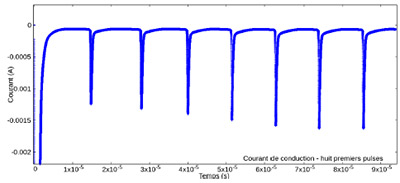
Below: Positive ion density profile during the first 4 pulses of the discharge
